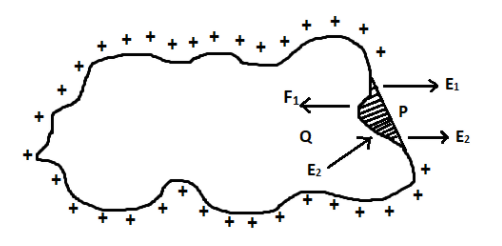Question
Question: Derive an expression for mechanical force per unit area of surface charge density....
Derive an expression for mechanical force per unit area of surface charge density.
Solution
The quantity of charge contained per unit area is called surface charge density. All charged conductors will experience some mechanical force. Elements having a surface charge density will always experience a mechanical force outwards. Here we have to derive an expression for the mechanical force.
Complete step by step answer:
Small elements of the conductor will experience a mechanical force normally outwards. Let us consider the small element dS as shown below,

Let σ be the surface charge density of the conductor. Then the charge carried by the small element dS be dq.
Then we can write,
dq=σdS -------(1)
Let us consider a point P outside the small element as shown in the figure.
At this point P, the electrical intensity can be written as,
E=ε0kσ -------(2)
where ε0 stands for the permittivity of free space and k stands for the dielectric constant.
The electrical intensity is directed normally outwards.
The electrical intensity E can be resolved into two components, E1 and E2.
E1 is the component of electrical intensity due to the small charge dqpresent in the element.
E2 is the component due to the rest of the charges present on the surface.
Hence the total electrical intensity at the point P can be written as,
E=E1+E2
Substituting this value in equation (2)
E1+E2=ε0kσ --------(3)
Let us now consider the point Q. At this point, the components of electrical intensity are in opposite direction. Inside the charged conductor the total charge is zero.
i.e.
E1−E2=0
∴E1=E2
Substituting E1=E2 in equation (3)
We get
E2+E2=ε0kσ
This can be written as,
2E2=ε0kσ
From this, we can write E2 as,
E2=2ε0kσ
We know that the electrical intensity due to the rest of the charges in the conductor is E2. The element dS of the conductor will experience a repulsive force due to this component.
The repulsive force experienced by the rest of the conductor due to the charge dq in the small element dS is given by,
F=E2dq
We know that E2=2ε0kσ
and dq=σdS
Substituting these values in the equation for force,
F=2ε0kσ.σ.ds=2ε0kσ2dS
From this equation, we can write
dSF=2ε0kσ2
The force per unit area can be written as, dSF=f
Thus the above equation will become,
f=2ε0kσ2
This is the mechanical force per unit area of a conductor due to a surface charge density.
Note: The S.I unit for the mechanical force per unit area is given by N/m2. Like charges repel each other and unlike charges attract. In a charge-carrying conductor, the charges are all similar. Hence when we consider a small element the rest of the conductor will experience the mechanical force due to the repulsion of like charges.
